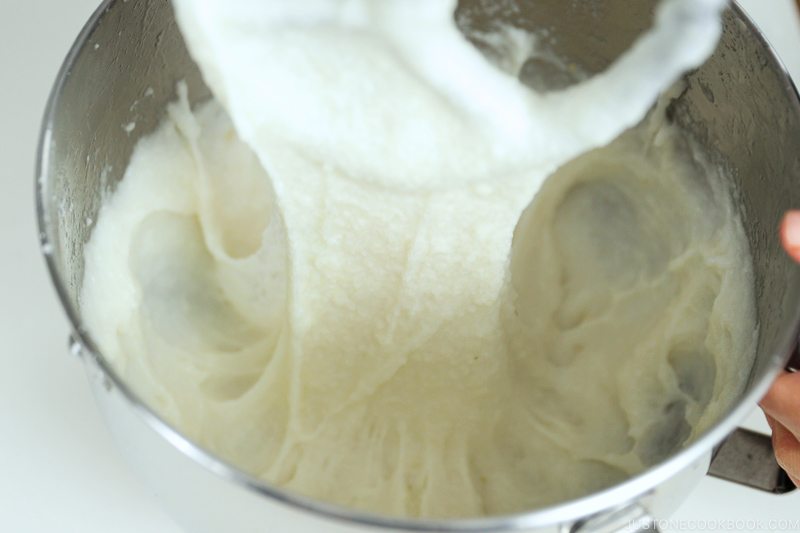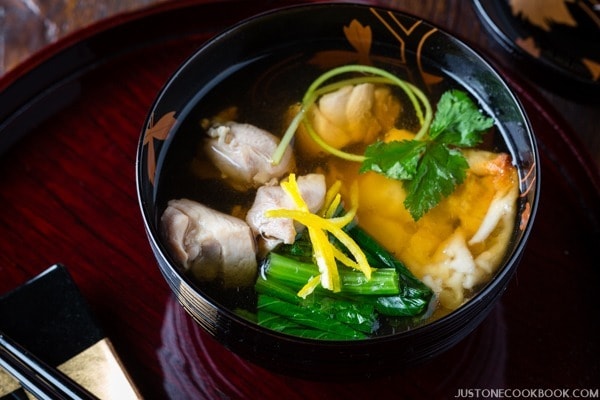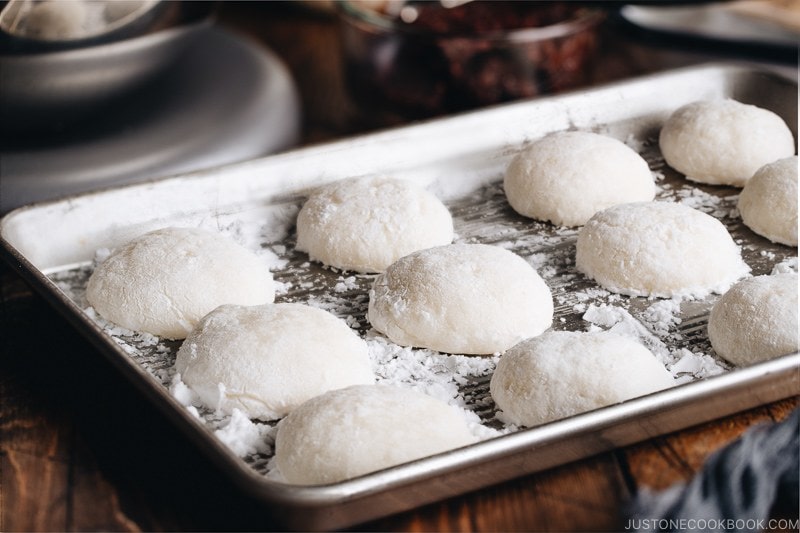
Make fresh homemade mochi using a stand mixer! Stuff the mochi with your favorite filling, dip in a savory or sweet coating, or enjoy in Japanese New Year Soup and red bean soup.
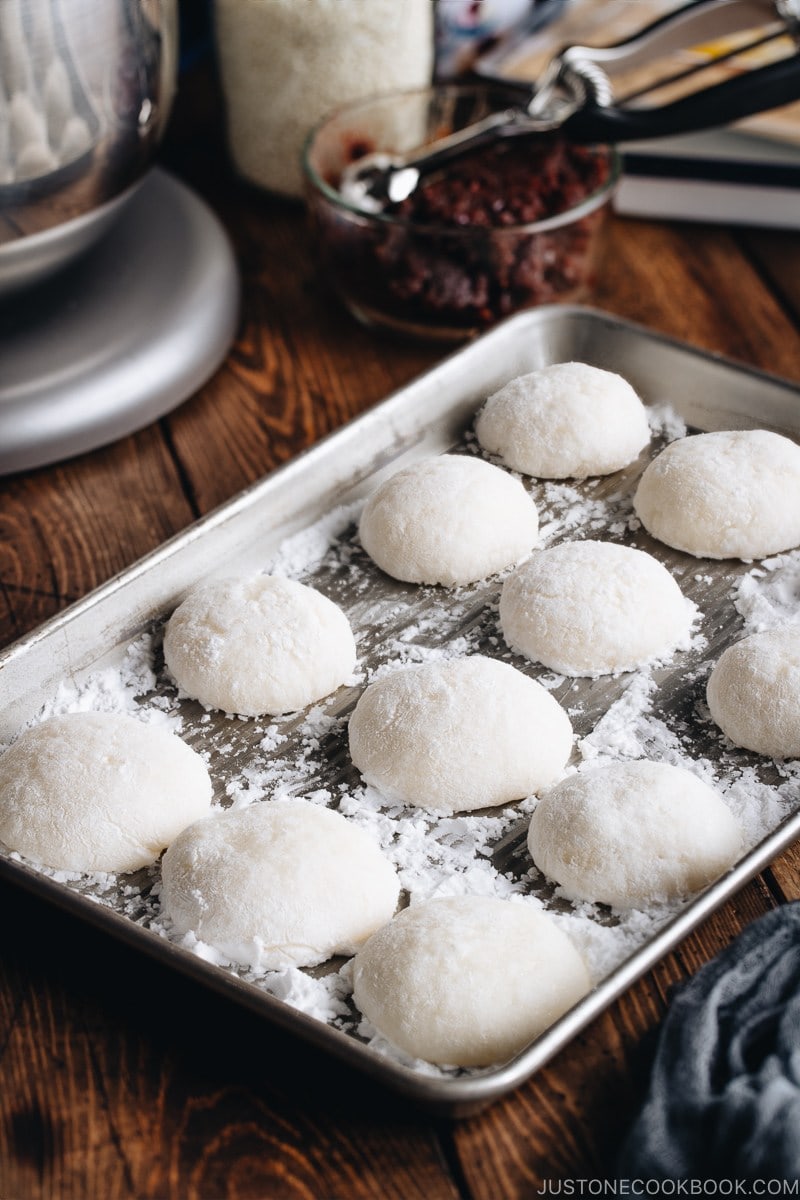
Sticky and chewy Mochi (餅) is irresistible. Whether it’s Mochi Ice Cream, Strawberry Daifuku Mochi, or mochi enjoyed during traditional Japanese New Years, these elastic wonders of glutinous rice cakes have captured the hearts of people worldwide. In the US, you can even find the mainstream mochi creations at major grocery stores like Trader’s Joe and Whole Foods.
Today I’ll show you how to make fresh homemade mochi with a rice cooker and stand mixer. It is a fairly easy affair, but I do want to warn you – mochi is super sticky and the process can be a handful. Don’t let that stop you though because there is nothing like eating freshly pounded mochi! They are smooth, springy, and tactile. A nostalgic reminder of my childhood and all the happy memories in Japan.
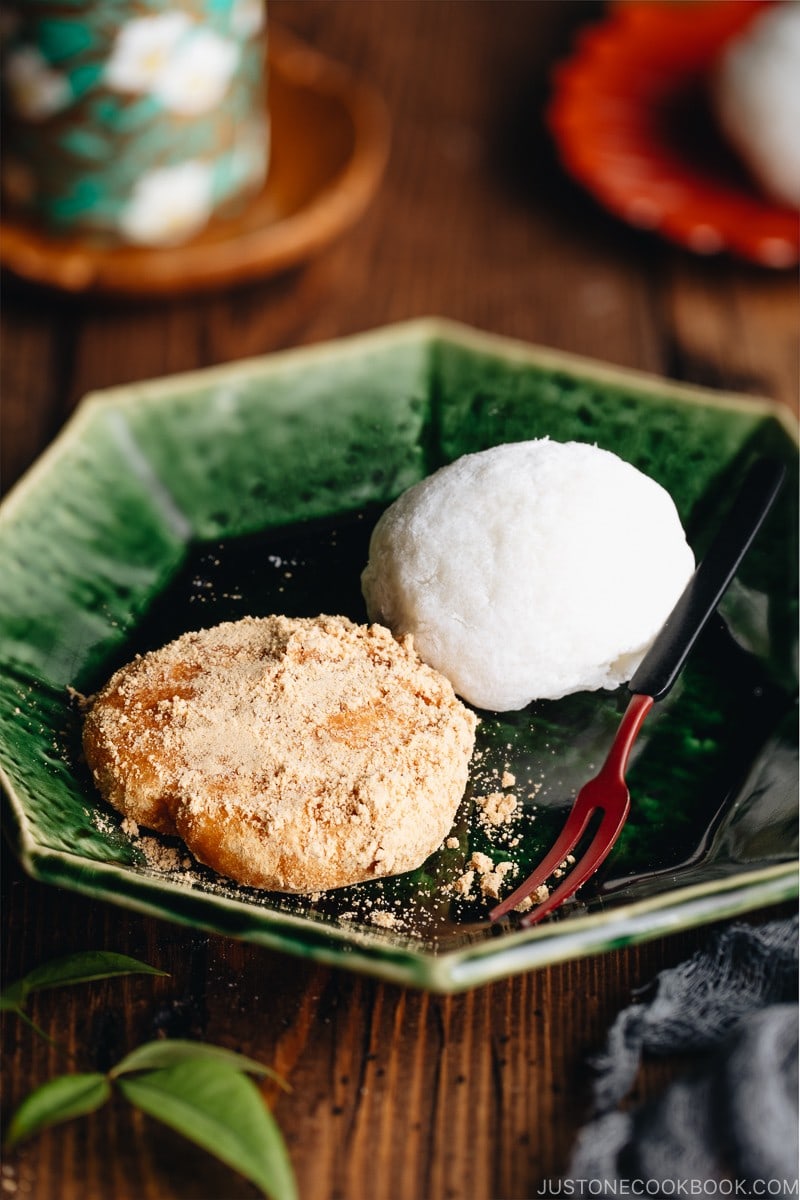
Watch How to Make Mochi with a Stand Mixer
First, take a look at the whole process in this video.
What is Mochi?
A fun fact: Mochi (餅, もち) is often pronounced as [MO-chi] in English, but we actually pronounce it [mo-CHI] in Japanese.
Mochi is Japanese rice cake made of mochigome (糯米), a short-grain glutinous rice*. It’s naturally white, sticky, elastic, and chewy. It tastes like rice without filling or coating, but mochi is all about the texture. There is no other food that has this unique texture similar to mochi.
Outside of Japan, mochi seems to be associated with desserts like mochi ice cream and mochi stuffed with sweet filling. However, when Japanese hear the word “mochi”, it usually implies the plain mochi that can be used for both savory and sweets. Think of it this way: if steamed rice is one form of rice, then mochi is another form of rice.
*It’s sometimes called “sweet rice” although they both mean the same thing. I’d just call “glutinous rice” in this post.

How Mochi is Made
Traditionally, glutinous rice is steamed first, then steamed rice is transferred into a Usu (臼), a large Japanese stamp mill, and then it is pounded with a pestle called Kine (杵). This mochi pounding event is called Mochitsuki (餅つき).
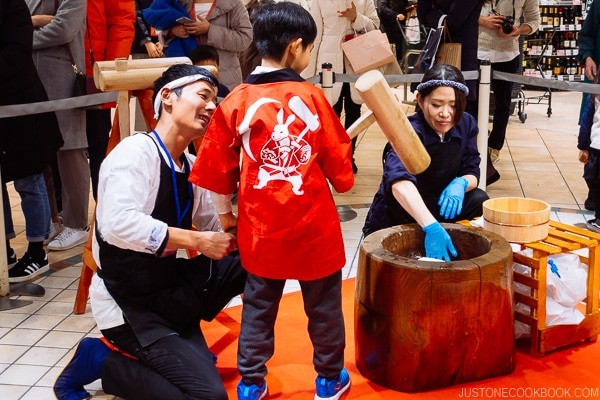
Glutinous rice is pounded repeatedly until smooth, sticky, and elastic. Some households own a bread machine with a “mochi making” function, which can cook and pound the glutinous rice (Isn’t it genius?). Some people own a mochi-pounding machine. Outside the big cities, people still make mochi the traditional way using family’s heirloom Usu and Kine. Mochitsuki is a family event that they continue on.
After mochi is pounded, it is transferred to a working station where you shape into round mochi balls or make big round pieces used for a decoration called Kagami Mochi (鏡餅) during the Japanese New Year. Making mochi is a big part of Japanese New Year preparation.
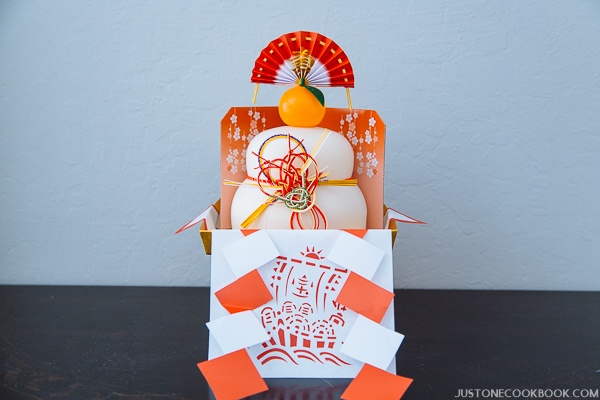
Today we will make fresh mochi without Usu & Kine, a bread machine, or mochi-pounding machine. We will make it with a rice cooker and stand mixer!
Before you start, keep these in mind:
- Accept that mochi is extremely sticky food. Embrace the gooey-ness and have fun!
- Don’t touch mochi with your bare hands/utensils. When kneading and pounding, always wet your hands and utensil. When shaping mochi, make sure your hands are dry and lightly dusted with starch.
- Soak the bowls and tools in water immediately. Mochi will come off easily by the time you clean up.
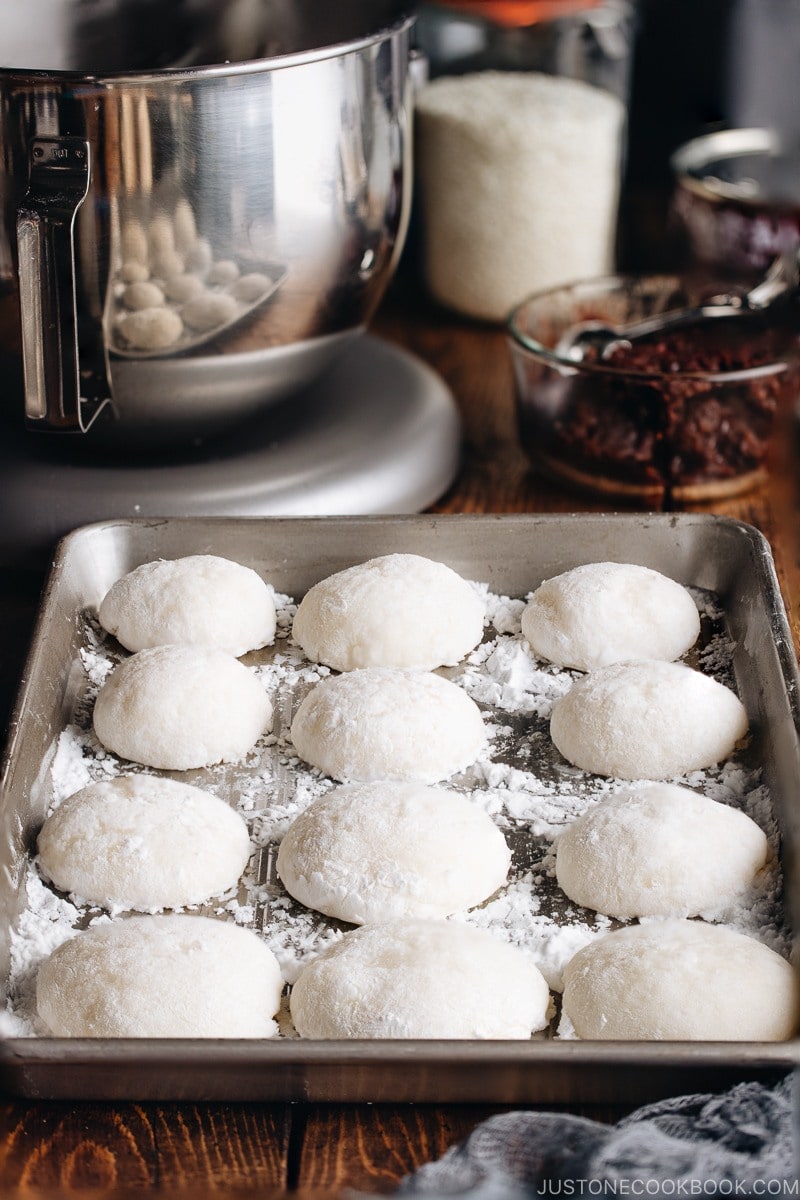
How to Make Mochi with a Stand Mixer – 3 Steps
- Cook glutinous rice in a rice cooker (or whatever method you use) – Easy
- “Knead” and “Pound” the cooked rice with a stand mixer. – Fairly easy
- Divide and make mochi balls – Mess alert! (just kidding, you can do it)
Step 1: Cook Glutinous Rice
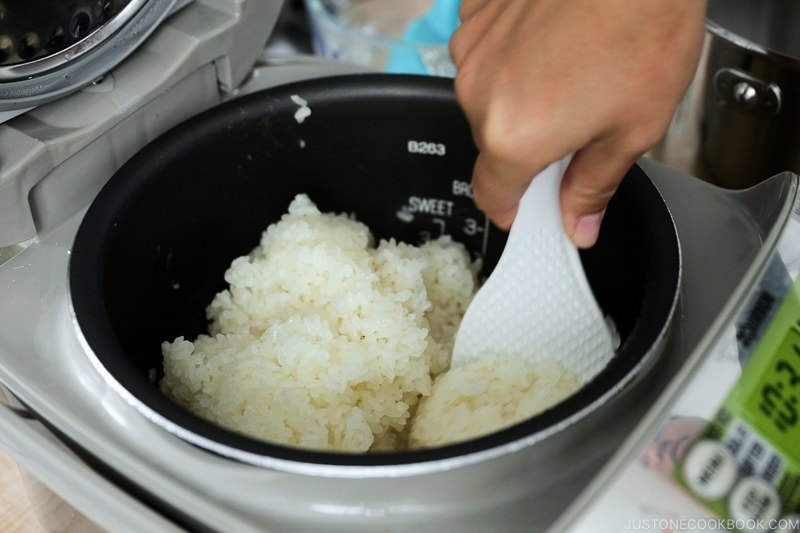
I decided to use a rice cooker method since it’s a standard electric appliance if you cook Japanese or Asian food frequently.
Rice Cooker: You do not need to soak the glutinous rice in water prior to cooking. Just rinse and cook the glutinous rice just like how you would cook regular steamed rice.
Steamer: Traditionally, glutinous rice is steamed in a steamer because it’s considered the best way. You would rinse and soak the rinsed glutinous rice in water overnight, put the rice in a cheesecloth, place inside the steamer, and steam for 30 minutes.
Instant Pot: You can use your Instant Pot if you have one. Soak the glutinous rice for 1 hour after rinsing, high-pressure cook for 5 minutes, and natural release for 15 minutes.
Pot on Stove: Rinse the glutinous rice, soak for 10 minutes, then put the rice and water in the pot. Start with high heat, and once boiling, mix the rice once and put the lid on. Turn the heat down to the lowest heat and cook for 8-10 minutes. Remove from the heat and let it steam for 10-15 minutes.
Step 2: “Knead” and “Pound” Using a Stand Mixer
At this step, you will need a few things:
- A timer (your smartphone would do)
- Hot water ready for use
- Silicone spatula (A flexible silicone spatula is easy to scrape down the mochi in the stand mixer)
- A 2-cup measuring cup for soaking the spatula
This stand mixer process involves 2 stages:
- “Knead” with a dough hook for 3 minutes – repeat 4 times [total 12 minutes]
- “Pound” with a flat beater for 30 seconds – repeat 4 times [total 2 minutes]
Step 3: Shaping Mochi Balls
Here’s what you’re going to do:
1. Thinly coat the mochi with potato starch.
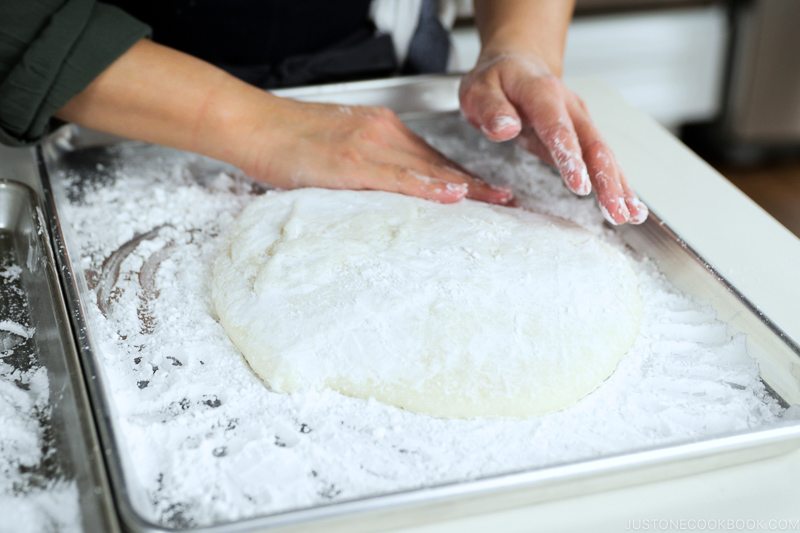
2. Pull up a corner and tuck in the edges underneath to create a small mound. Kep pulling and tucking until it’s thick enough.
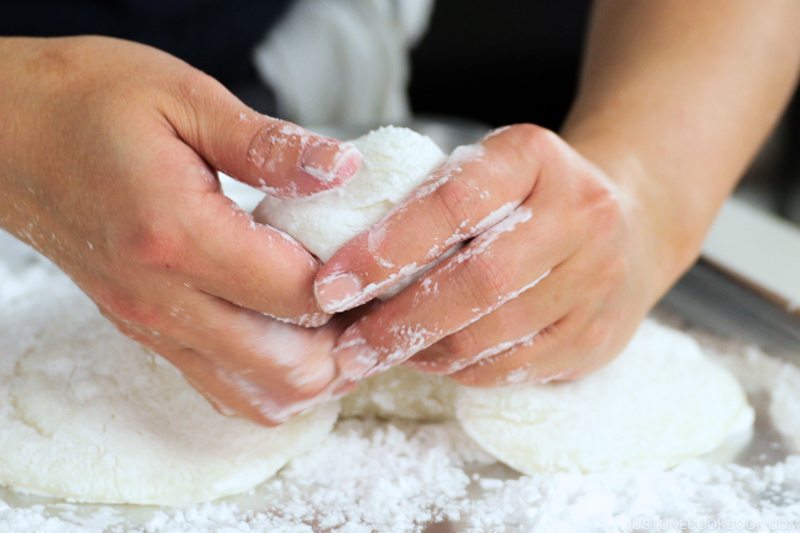
3. Make a “C” with your well-dusted, left pointing finger and thumb, and then place the “C” fingers on top of the thick corner.
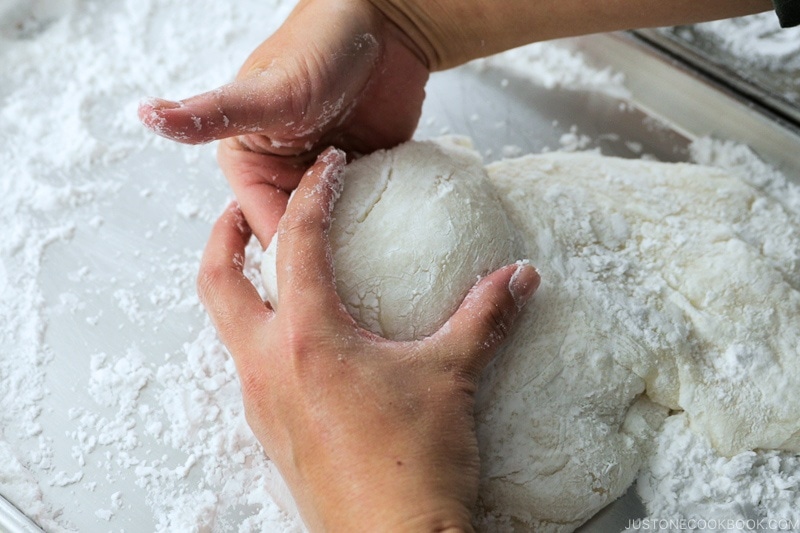
3. With your right hand, tuck and squeeze the mochi into the left “C” fingers from underneath and side to make a ball shape.
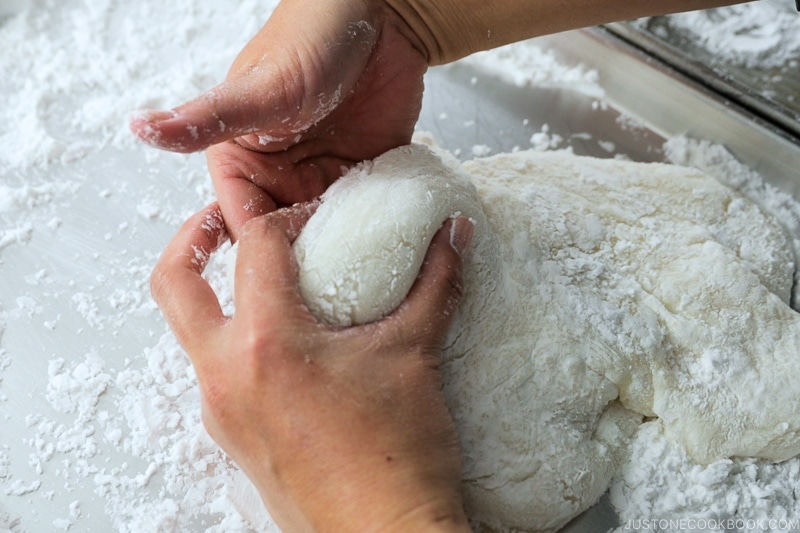
4. Once you get a good-size ball shape that’s slightly bigger than a golf ball, pinch the mochi with your left “C” fingers. Use the right hand to twist it off.
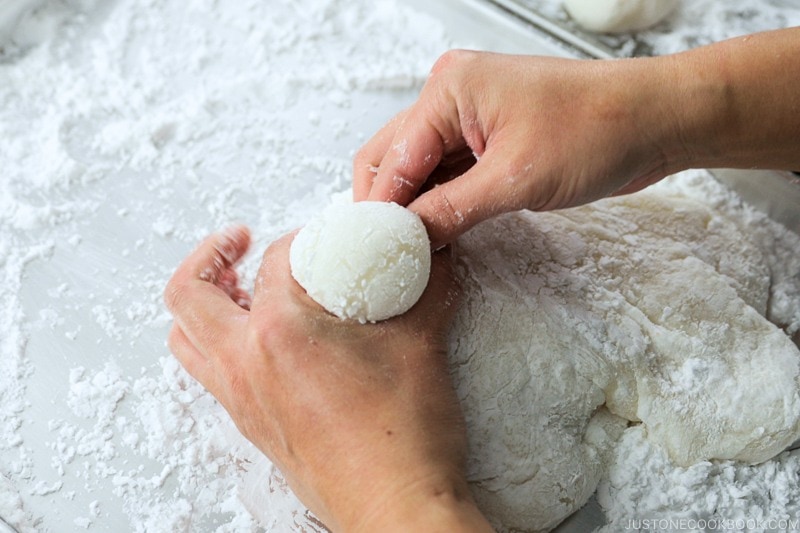
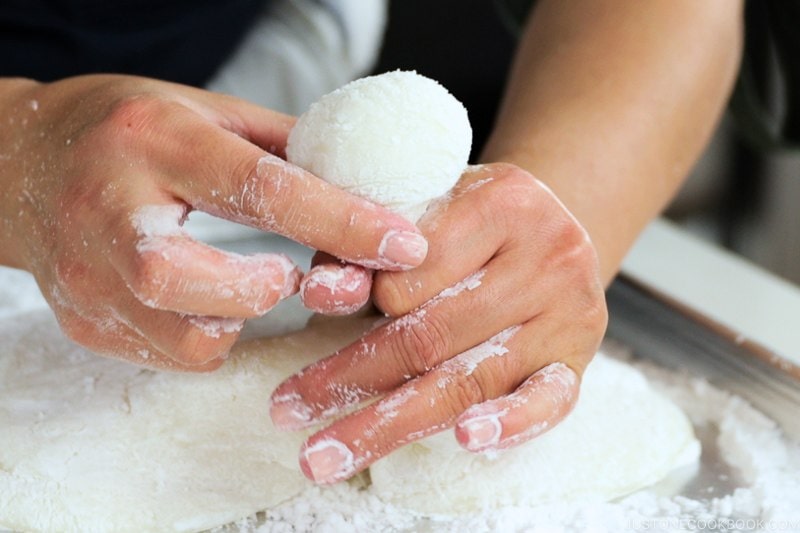
When pinching, do not pull the mochi because the sticky surface would appear and your hands would get messy. Instead, use Pinch & Twist motion to cut the mochi with two “C” fingers and right hand. Make sure your hands are dry and well-dusted with potato starch.
5. Quickly rotate the mochi on dusted hand to cover up the sticky new surface.
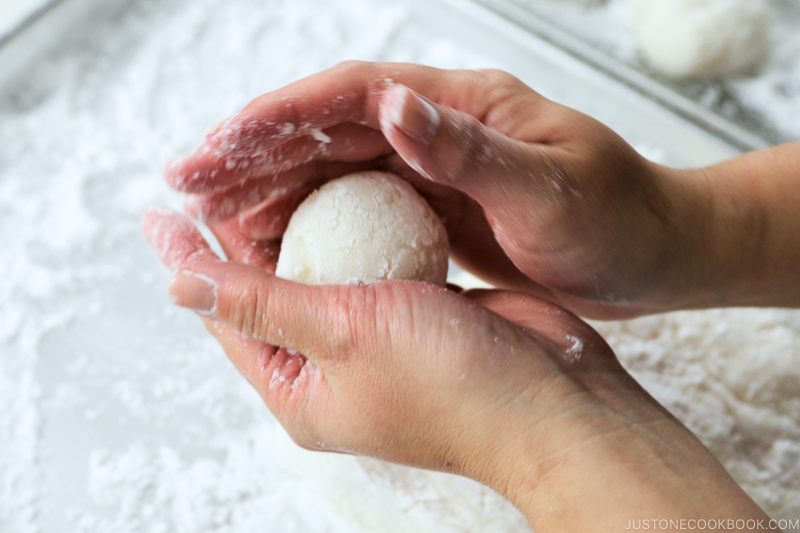
REMINDER:
- Handle the areas dusted by starch only and make sure your hands are dry and well-dusted.
- Do not to “pull” the mochi, which creates a fresh sticky surface.
- If you see any sticky surface appearing on mochi, lightly dust a thin layer of starch and brush the excess away. Too much starch would be troublesome when you stuff the filling and close the mochi.
*Please watch my video. Sometimes it’s easier to see in action than reading my instructions.
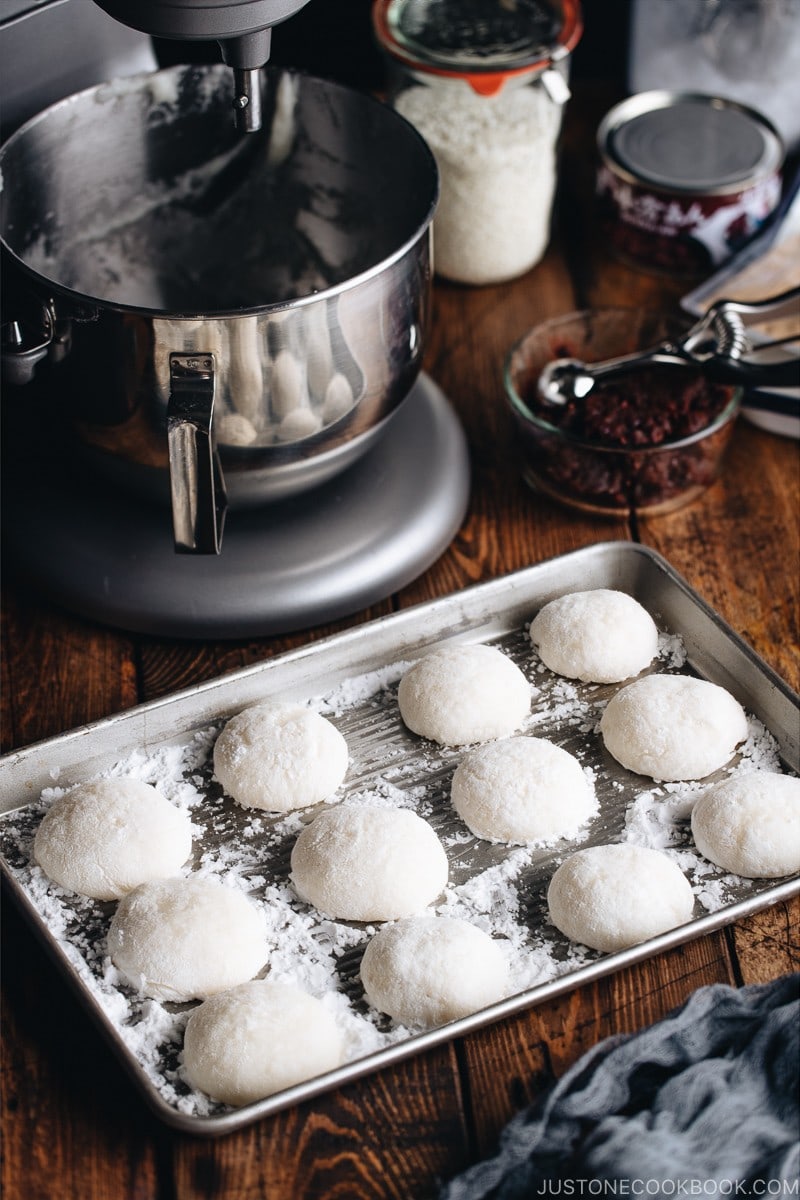
How to Eat Fresh Homemade Mochi
There are so many ways to enjoy fresh homemade mochi. Here are some common ways to enjoy it.
Put mochi in a soup
- Kanto (Tokyo)-style Ozoni (New Year Soup)
- Kansai (Osaka)-style Ozoni (New Year Soup)
- Zenzai/Oshiruko (Red Bean Soup)
Stuff mochi with a sweet filling
- Anko (sweet red bean paste) – See the recipe below
- Ice cream of your choice
Coat mochi with a sweet/savory sauce
- Kinako (soybean flour) + sugar – See the recipe below
- Soy sauce + sugar
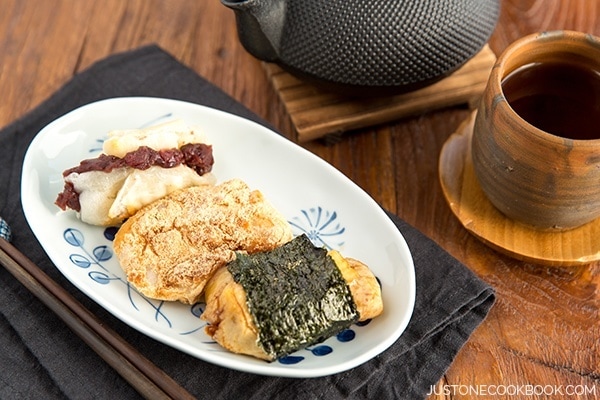
Make mochi into Japanese New Year decoration
- Kagami Mochi (decorate until 1/15)
Make mochi into rice crackers
- Make it flat and air dry until completely dry. Then toast the mochi on both sides in the oven. Brush with soy sauce and air dry.
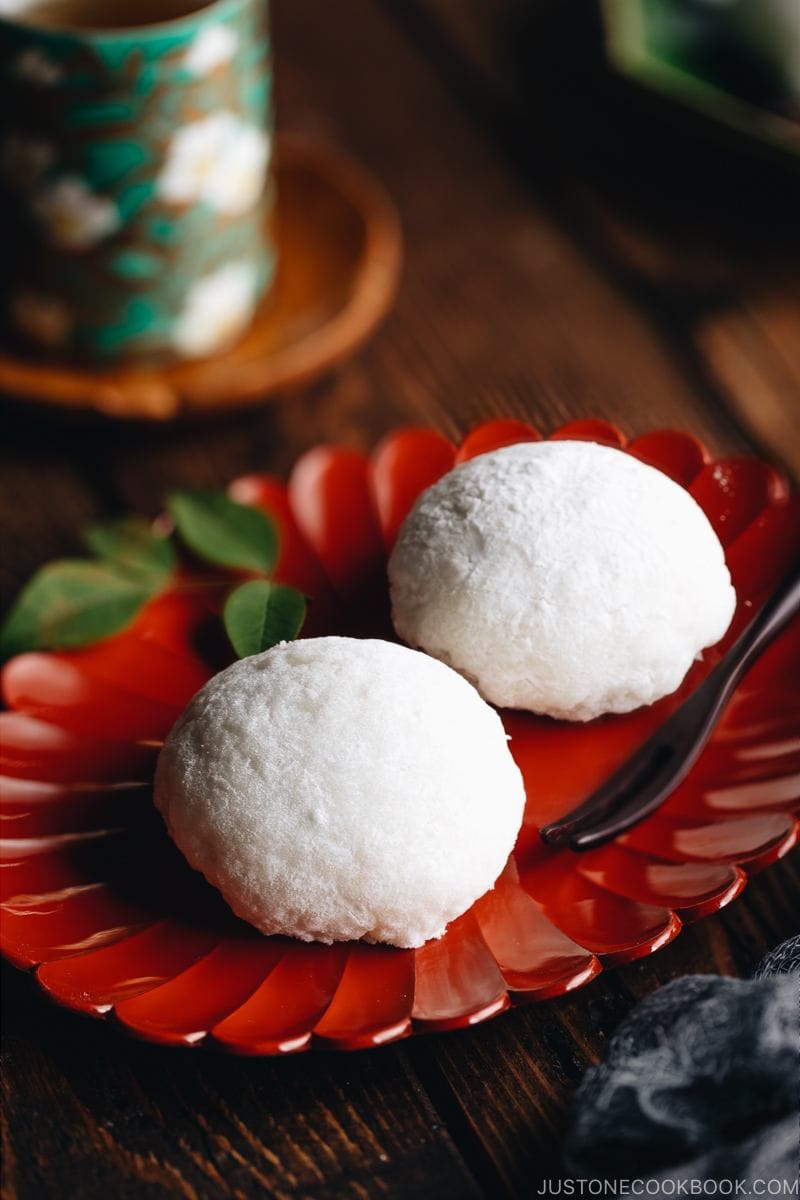
Frequently Asked Questions
1. Can I use other types of rice?
No, for this recipe, I only tried with Japanese short-grain glutinous rice. I had never tried other types of rice such as long-grain glutinous rice, therefore I would not know how much water you need to cook the rice, how long it takes to knead/beat, etc.
2. Can I make a bigger batch?
To be honest, I am not so sure because I don’t think my Kitchen Aid stand mixer would be able to knead more mochi inside the bowl. With 3 rice cooker cups of glutinous rice, it was working hard, and I wouldn’t feel comfortable doing even a bigger batch. So I would suggest making a few batches.
4. Can I freeze the mochi? How long does it last?
Yes, you can freeze the mochi! For the best quality, eat it within a month, but mochi can be kept in the freezer for 6 months if you store them well.
5. Does it taste like freshly pound mochi made in Usu and Kine (traditional method)?
I wish! The stand mixer cannot do a real “pounding” motion and the mochi is not 100% made in the same way. However, if my choice was between store-bought mochi vs. homemade mochi, I would choose to make it in a stand mixer. It is actually amazing! The mochi’s texture is 95% close to the ones made traditionally. I just wish that it yields a real smooth and silky surface. That said, the difference is not obvious.
Ready to make some mochi from scratch? Time to gather your kids or mochi-loving friends for this sticky, fun and auspicious activity!
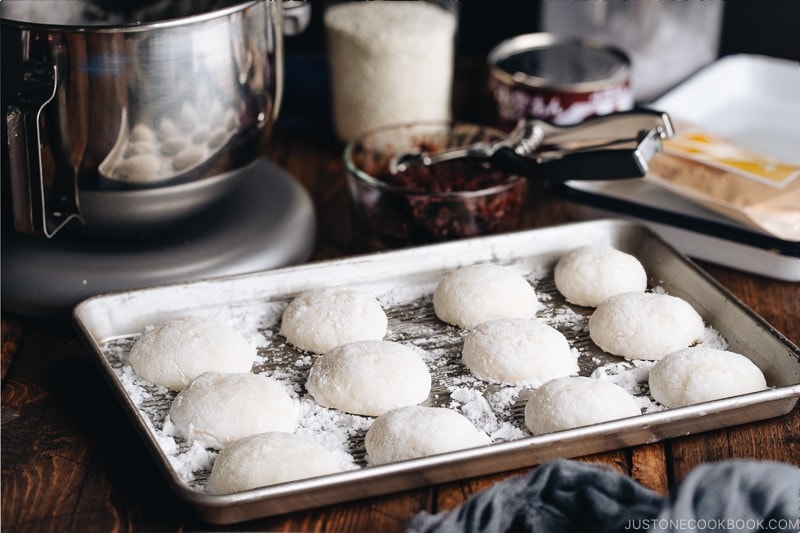
Japanese Ingredient Substitution: If you want to look for substitutes for Japanese condiments and ingredients, click here.
Sign up for the free Just One Cookbook newsletter delivered to your inbox! And stay in touch with me on Facebook, Pinterest, YouTube, and Instagram for all the latest updates.
How to Make Mochi with a Stand Mixer
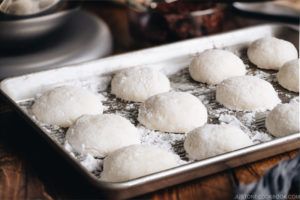
Make fresh homemade mochi using a stand mixer! Stuff the mochi with your favorite filling, dip in a savory or sweet coating, or enjoy in Japanese New Year Soup and red bean soup.
- 450 g glutinous rice (sweet rice, mochigome) ((= 3 rice measuring cups or 540 ml))
- 400 ml water ((It should be 3 cup line for Sweet Rice in rice cooker bowl))
Anko Mochi
- red bean paste (anko) ((See Notes for homemade recipe))
Kinako Mochi
- 2 Tbsp Kinako (soybean flour) (This makes 2 mochi balls. If you're making more, follow the ratio of 2 parts kinako: 1 part sugar))
- 1 Tbsp Sugar
To Measure and Rinse Glutinous Rice
- Measure the glutinous rice. 1 RICE MEASURING CUP (180 ml) of glutinous rice is 150 grams. You will need 3 rice cooker cups (540 ml), which is 450 grams.
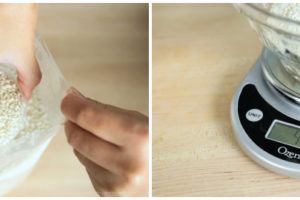
-
To rinse the glutinous rice, put the rice in a large bowl and add some water. Stir with your hands and quickly drain the water.
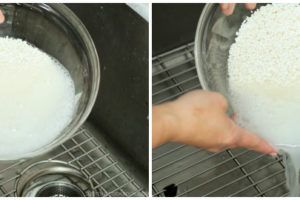
- Then gently stir the rice with your fingertips. Glutinous rice is easily broken, so you don’t need to use your strength. Just stir a few times.
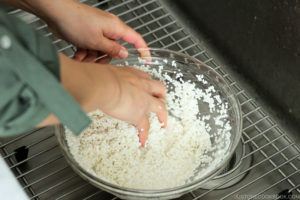
-
Add water in the bowl, and carefully rinse for 4-5 times. Drain the rice into a fine mesh sieve/colander.
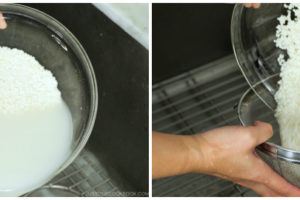
-
Shake the sieve/colander to remove excess water. Then transfer the rice into the inner pot of rice cooker.
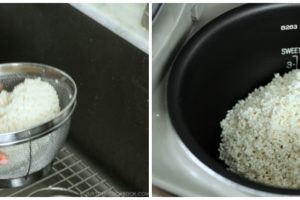
-
Make the rice flat and add 400 ml/gram of clean water. The water should be at 3-cup line for SWEET RICE. Evenly distribute the rice with chopsticks or fingers.
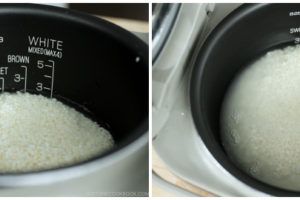
To Cook Glutinous Rice
-
Close the lid of the rice cooker. Select “REGULAR” on the menu and start cooking. REGULAR cooking is usually 5-10 minutes longer than “SWEET” setting. As soon as the rice is cooked, we can take it out immediately.
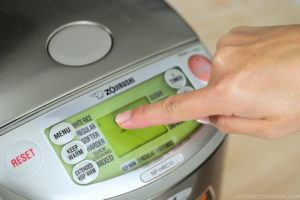
-
When the rice is almost done, prepare about 4-5 cups boiling water. Once the hot water is ready, pour 1/3 boiled water into your stand mixer bowl to keep warm, 1/3 into a mixing bowl that can soak a dough hook and a flat beater, and the rest into a 2-cup measuring cup that can soak a silicone spatula. Make sure the water is enough to cover the tools.
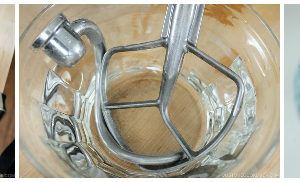
- Discard the hot water in the stand mixer. Transfer all the cooked glutinous rice into the stand mixer.
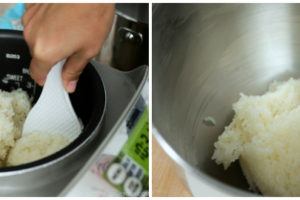
To “Knead” with Dough Hook Attachment
- Set the dough hook attachment in your stand mixer. Start kneading the glutinous rice with Number 2 Speed. Set timer for 3 minutes. (Repeat the process 4 times.)
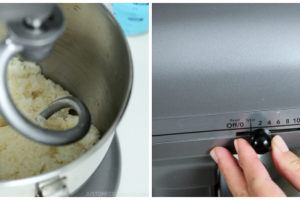
-
The dough hook will start pulling in the rice.
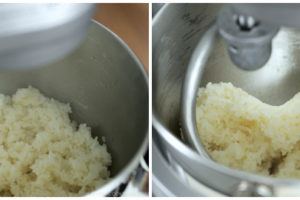
- [Optional] While kneading, you can use your wet silicone spatula to detach the glutinous rice from the wall of the stand mixer.
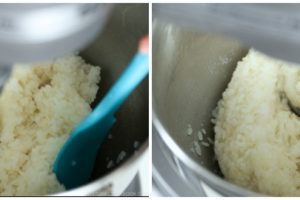
- 3-minute timer beeps [03:00]. Remove the bowl from the stand mixer, keeping the dough hook attached. Using the wet silicone spatula, flip the glutinous rice. Dip the spatula in water a few times so it doesn’t get sticky.
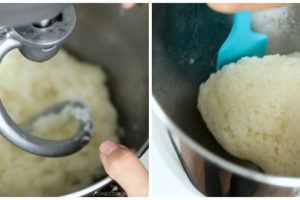
- Put the bowl back to the stand mixer and start kneading again with Number 2 Speed. Reset timer for 3 minutes.
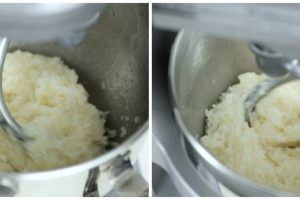
- 3-minute timer beeps [06:00]. Remove the bowl from the stand mixer, and flip the glutinous rice again, using the wet silicone spatula. Now the rice grains are less visible and start to look like mochi.
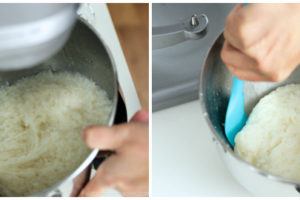
- Put the bowl back to the stand mixer and start kneading again with Number 2 Speed. Reset timer for 3 minutes.
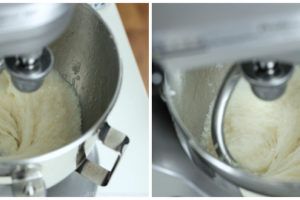
- 3-minute timer beeps [09:00]. Remove the bowl from the stand mixer, and flip the glutinous rice again, using the wet silicone spatula. Now it’s getting stickier and elastic.
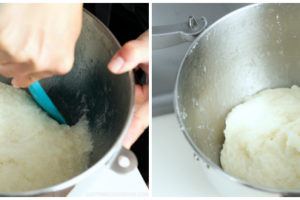
- Put the bowl back to the stand mixer and start kneading again with Number 2 Speed. Reset timer for 3 minutes.

- 3-minute timer beeps [12:00]. Remove the bowl from the stand mixer, and flip the glutinous rice again, using the wet silicone spatula. Now the kneading is completed.
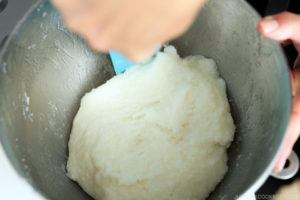
To "Pound" with Flat Beater Attachment
- Remove the dough hook attachment from the stand mixer and change to a flat beater attachment.
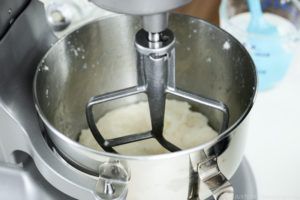
- Beat the mochi with Number 3 Speed. Set timer for 30 seconds. (Repeat the pounding process 4 times.)
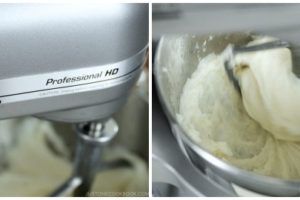
- 30-second timer beeps [00:30]. This time you do not need to remove the bowl from the stand mixer. Scrape mochi as much as you can from the side of the bowl, using the wet silicone spatula.
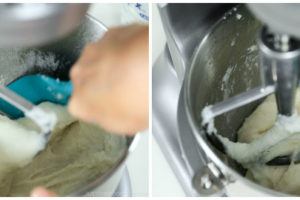
- Reset timer for 30 seconds. Start beating again with Number 3 Speed. 30-second timer beeps [01:00]. Scrape mochi again from the side of the bowl, using the wet silicone spatula.
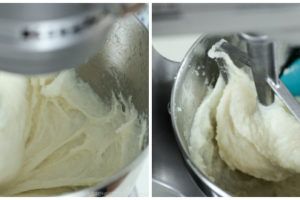
- Reset timer for 30 seconds. Start beating again with Number 3 Speed. 30-second timer beeps [01:30]. Scrape mochi again from the side of the bowl, using the wet silicone spatula.
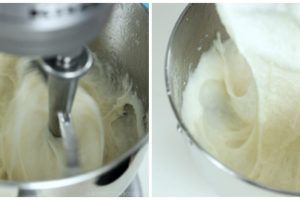
- Reset timer for 30 seconds. Start beating again with Number 3 Speed. 30-second timer beeps [02:00]. Scrape mochi again from the side of the bowl, using the wet silicone spatula. Now the pounding is done.
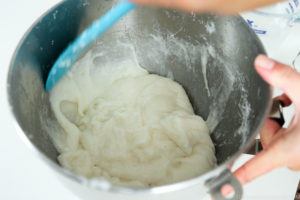
To Shape into Mochi Balls
-
Prepare two rimmed baking sheets by covering them with potato starch. Put all the mochi on one of the baking sheets. The other one is for keeping mochi balls.
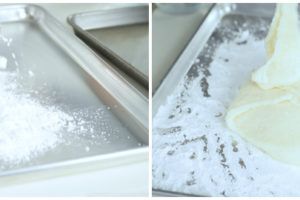
-
Sprinkle some potato starch on top of the mochi. Make sure your hands are completely dry and cover them with potato starch. Keep extra starch handy so you can always dust your hands when needed.
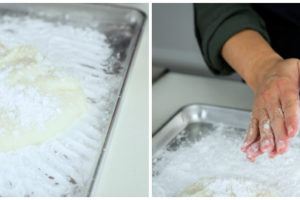
-
Spread the potato starch on top of the mochi, making sure there is no sticky part left. Pick up a corner of the mochi and start tucking in the edges underneath.
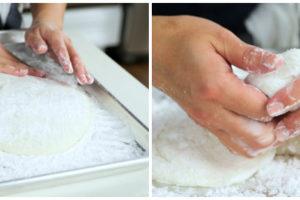
- When it becomes a mound of a thick layer, make a “C” with your left pointing finger and thumb over the edge of mochi.
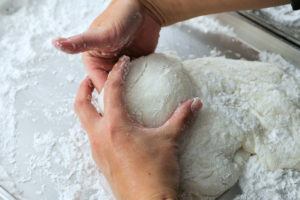
- Using your right hand to tuck in and push up the mochi underneath to create a ball shape above “C” fingers.
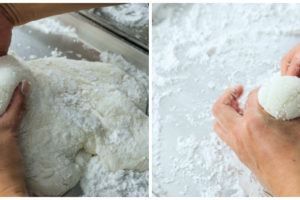
-
Using the “C” fingers, pinch underneath the ball to cut off the mochi. Use the right hand to assist by twisting. Do not pull the mochi as it creates stick surface.
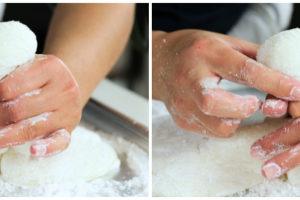
-
This is a bad example. You don’t want to pull the mochi. The sticky mochi surface appears and now your hands get sticky when you touch it. REMEMBER: Pinch & Twist. Pinch & Twist.
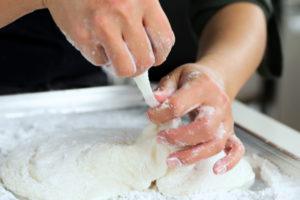
-
Once you make the mochi balls, transfer to the other rimmed baking sheet. When you’re ready to use, dust off the starch with a pastry brush or with your dry hands. Enjoy your mochi in Japanese New Year Soup (Ozoni) and Red Bean Soup, or make Anko Mochi or Kinako Mochi (see below)

To Store
-
If you do not use the mochi immediately, cover each one individually with plastic wrap and put in the freezer bag.
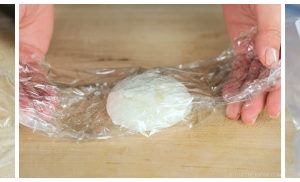
[Optional] To Make Anko Mochi
- Flatten the mochi ball by pressing down.
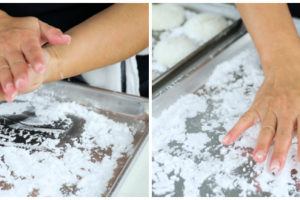
- Brush off excess starch by hands or a pastry brush. This is an important step so don’t skip.
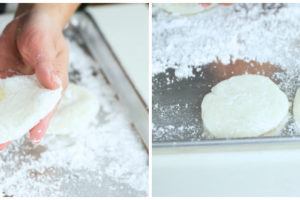
- Put the anko (sweet red bean paste) in the center of each mochi. Pull two sides of the mochi.
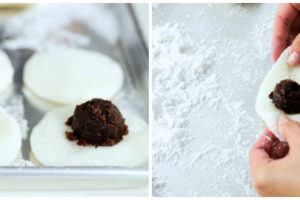
- Pull up the sides and pinch over the anko. Repeat for the other sides and pinch on the top.
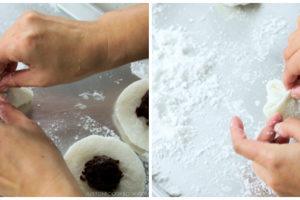
-
Lightly dust your hands with potato starch (do not overcoat). Use a light pressure to pinch and seal the top of mochi.
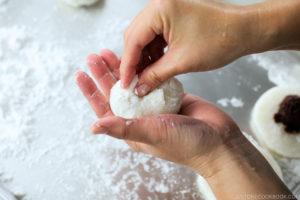
[Optional] To Make Kinako Mochi
- In a bowl, combine kinako (soybean flour) and sugar (Ratio: 2 parts kinako, 1 part sugar) and mix well.
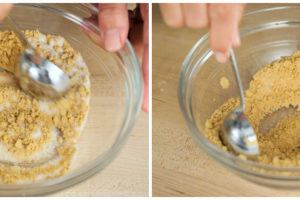
-
Pour hot water in a separate bowl. Dip a mochi ball in the hot water.
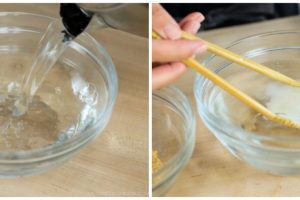
- Coat well with the kinako mixture and repeat with the rest. They can be served immediately.
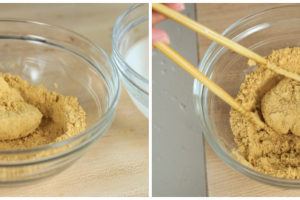
Homemade Red Bean Paste (stovetop): click here for the recipe.
Homemade Red Bean Paste (pressure cooker): click here for the recipe.
Japanese Ingredient Substitution: If you want to look for substitutes for Japanese condiments and ingredients, click here.
Recipe by Namiko Chen of Just One Cookbook. All images and content on this site are copyright protected. Please do not use my images without my permission. If you’d like to share this recipe on your site, please re-write the recipe in your own words and link to this post as the original source. Thank you.
